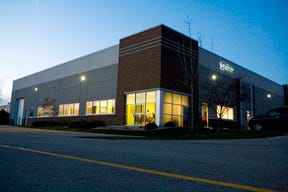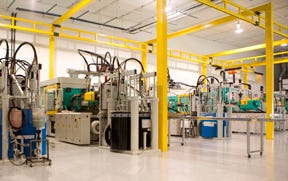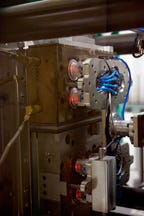Plant Tour: Hard lessons from a soft material
What do Colombia, Brazil, Düsseldorf, and Madison, WI have in common? They trace the circuitous path Enrique Camacho and Simtec Silicone Parts have taken to preeminence in the burgeoning market for injection molding liquid silicone rubber (LSR), including the unique capability to combine LSR and thermoplastics in the same part on the same machine.
January 13, 2010
What do Colombia, Brazil, Düsseldorf, and Madison, WI have in common? They trace the circuitous path Enrique Camacho and Simtec Silicone Parts have taken to preeminence in the burgeoning market for injection molding liquid silicone rubber (LSR), including the unique capability to combine LSR and thermoplastics in the same part on the same machine.
Born in Colombia and having worked for several years in plastics, Enrique Camacho too turned to full-time processing, at first working in thermoplastics. After watching several machines running LSR parts at the K 2001 show in Düsseldorf, Germany, Camacho was immediately struck by the potential niche the unique material could provide, and soon set up an LSR molding facility in Brazil. In a year’s time, Camacho decided a new locale could help him fully tap LSR’s potential.
|
“We saw the potential of the North American market for silicone rubber parts, and especially two-shot applications,” Camacho says, “and with that in mind, we made the decision to start an operation here in North America.”
After scouting several cities in the states, as well as abroad, Camacho settled on Madison, WI, where he founded Simtec in March 2002. “We decided to have the production concentrated in one country and in one city,” Camacho says, citing also the importance of receiving LSR shipments from the five major suppliers, who have U.S.-based operations, without worrying about longer logistics lines and the possibility of import duties.
Madison was also appealing because of the University of Wisconsin at Madison’s Polymer Engineering Center. The company has had an ongoing relationship with the center, which has resulted in the publication of several papers, research projects comparing properties of LSRs and high-cure rubbers at the molecular level, as well as investigations into the benefits of using a two-shot process as opposed to a conventional single shot.
Two material classes, one production cell
Simtec’s niche within a niche is the production of thermoplastic/LSR components that combine the two materials in one process in one production cell, using one of the first two-shot injection cells in the Western Hemisphere, according to Camacho. “The type of parts we make didn’t exist seven years ago,” Camacho explains. One such two-shot part is for a customer in France, with final assembly handled in Asia. Looking at the proposed design, the company asked itself, “Why don’t we integrate several functions in one part?” Employing an Arburg Allrounder 570S and an Austrian-made tool, the system shoots the thermoplastic substrate first using a hot runner, and then rotates the tool cavities to cold runners, which directly overmold LSR onto the substrate, resulting in a mechanical and chemical bond.
At this time, there are four different programs utilizing the two-shot technology, with components headed to the infant care, industrial, and cosmetic markets. The current applications combine LSR with polybutylene terephthalate (PBT) and LSR with polyamide (PA), with previous projects having joined LSR and polycarbonate (PC).
“The key here is we’re using the same production cell to integrate both materials,” Camacho says, “so you make it in sequence. First you inject the plastic substrate, then you inject the LSR so you get materials integration and consolidation of several parts and functions into one component.”
The two-shot applications typically run in 8+8-cavity tools, with cycle times ranging from 40-60 seconds. Mold cavitation ranges up to 128 for Simtec in single-material applications, with cycles there in the low 20-seconds. At the piece-part cost level, Camacho says the two-shot system makes economic sense as well.
“Two-shot molding enables you to save a substantial amount of money in terms of the number of tools you need for the production of parts,” Camacho explains, “as well as engineering hours and validation costs, while at the same time improving the quality level.”
|
The allure of LSR
So what did Camacho see at those stands at K that convinced him a business plan might be in order? “We have worked with silicone from the beginning because it’s a niche we identified as having the opportunity to bring additional technology to this country,” Camacho says. Silicone is better established in Europe and parts of Asia (Japan, for example), but its unique properties didn’t have much of a foothold in North America when Camacho set up shop in Wisconsin.
That said, Camacho admits that he didn’t have a background in LSR, but that doesn’t mean he didn’t have a plan. Hiring headhunters to scour Europe for experienced LSR hands, Camacho started to build out the on-staff expertise that would be required, but he also accepted early on that familiarizing himself with silicone would be a continuous process.
“The learning curve, of course, is not the easiest,” Camacho admits. “Some people might think we have nothing to learn; we learn something every single day.” From new grades, new processes, and new ways of integrating components, to the demanding requirements of the markets it serves, including Food & Drug Administration (FDA) food contact and medical device standards, there is always more knowledge to be gained.
One can describe LSR and its properties through a variety of traits, including strong thermal properties, heat/chemical resistance, good memory, and high durability, but for Camacho, two statements are particularly apt. “LSR is not for single-use components,” Camacho says. “It is not a commodity.”
In an era that has seen all manner of materials, markets, and applications relabeled as commodities and soon thereafter outsourced to distant shores, serving noncommodity markets represents a sound strategy, now and in the future.
“The sky’s the limit for LSR,” Camacho says. “Silicone is such a versatile material—there are so many markets where you can apply it. For our company, we consider ourselves a hub and there are several spokes out there, and we say we’ll supply the knowledge that we have across several industries. There are several parts that are in the development phase right now in industries that one wouldn’t even think would have applications for LSR.”
One potential downside to LSR is the material’s cost, coupled with the fact that, as a thermoset, once it’s scrap, it’s truly scrap. Simtec acknowledges this fact and aggressively works to root out any waste from its processes, starting with the tooling. By employing tools with direct injection nozzles for every cavity, including the 128-cavity molds, Simtec asserts it can shoot flash-free LSR parts. Because of the low viscosity of LSR, it is typically prone to seeping into the parting line and leading to flash, which must be trimmed. “The parts are injected directly into the cavity,” Camacho says. “The only ‘scrap’ you have is when you start up the machine for production.”
Expansion plans
Last year, as the broader economy and the plastics industry largely reeled from the effects of a global, synchronized recession, Simtec entered an expansion mode that will accelerate in 2010. “We have always been contrarians,” Camacho says. “Even in this year [2009], where other companies said, ‘We have to halt our investment and lay off employees,’ we carried forward with several investments, and that’s one of the keys to our success.”
The company added two molding machines in 2009, one two-shot and one single-shot, bringing its full fleet to nine (three two-shot, six single-material machines), with clamp tonnage from 85-242 tons.
In 2010, the company hopes to dramatically expand that fleet and the manufacturing footprint it occupies. Camacho says they will work to roughly double their shop floor to 30,000 ft2, while adding 16 molding machines over the coming years. At this time, the company runs a mix of Engel and Arburg presses and plans to continue to do so. The company also offers whiteroom molding, but would take the next step to cleanroom operations should the customer need arise.
Camacho won’t reveal exact sales, but will say that revenue in 2009 grew “substantially,” prompting the expansion, which is also being fueled by a number of projects that were “in the pipeline” when the company spoke with IMM.
Crowding out the competition
The appeal of LSR that first lured Simtec to the material has not been lost on other processors, with the ranks of LSR molders growing in recent years. “There are a lot of plastic processing companies that are trying to grab some share and gain entry into the LSR business,” Camacho says. “What I see is that it’s a very steep learning curve for everyone who tries to go into this market right now. It is a very expensive endeavor; it’s a capital-intensive industry.” The end result has been some frustrating experiences for LSR novices and their customers. “Some guys are getting their fingers burned,” Camacho says. “In order to make the parts with the quality you need and be as cost effective as possible, you have to really, deeply understand not only how to mold the parts, but how the material behaves.”
Where others founder, Simtec seizes opportunities on the basis of its best asset: knowledge. “We have customers in Europe, China, South America, and the U.S.,” Camacho says. “Why do they come to us? They come to us for one simple reason—we have the expertise they don’t get anywhere else.”
Vital Stats:
Simtec Silicone Parts, Madison, WI
Facility size: 11,000 ft2
Markets served: Industrial, medical, automotive, cosmetic, infant care
Parts produced: 780 million/year
Materials processed: Liquid silicone rubber (LSR) and for 2K PBT, PA, PC
No. of employees: 20
Molding machines: Nine, 85-242 tons, Arburg and Engel
Molding technology: Three two-shot machines
Other services: Material selection, design advice, prototyping, and serial production
Internal moldmaking: No
Quality: ISO 9001:2008 certified, ISO/TS 16949:2002 and ISO 13485:2003 compliant
See video of Simtec’s 2K thermoplastic/silicone parts being molded on the company’s website, utilizing transfer and rotating tool technology. Also, learn more about one of the company’s toolmakers, Rico Elastomere GmbH, from this 2005 story. —Tony Deligio
About the Author(s)
You May Also Like






